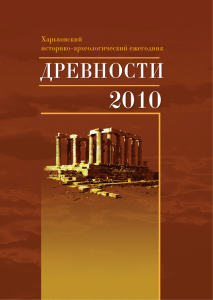Картографирование средневековых городищ Днепро-Донского междуречья как метод определения этапов славяно-кочевнических отношений
Анотація
Резюме
Колода В. В. Картографування ранньосередньовічних городищ Дніпро-Донського межиріччя як метод виявлення етапів слов'яно-кочівницьких взаємин
Стаття присвячена аналізу взаємин східних слов'ян і населення Давньої Русі з кочівниками степів Східної Європи. Спираючись на дані картографування городищ, контактної зони Дніпра — Сіверського Дінця, автор виділяє п'ять етапів цих взаємин, показує особливості кожного з них. На його думку, ініціатором цих відносин найчастіше виступали кочові народи, що пов'язане з особливістю їхнього соціально-економічного розвитку. Основними рубежами оборони слов'ян від агресії степовиків протягом практично всього державного періоду їхньої історії були ріки Сейм і Сула, а ріки Ворскла й Псел відігравали допоміжну роль. Найбільш тісні контакти спостерігаються на Сіверському Дінці, що виражається в наявності археологічних пам'яток кінця I тис. із синкретичными рисами в матеріальній і духовній культурі. Наявні дані дозволяють віднести початок періоду запустіння контактної зони («дикого поля») до межі ХIV—ХV ст.
Ключові слова: слов’яни, Київська Русь, Хозарський каганат, Золота Орда, городище, міжетнічні контакти.
Summary
V. Koloda. Mapping the early-Medieval Hillforts in the Dnieper and the Don Interfluve as a Method of Determination of Slavo-nomadic Relationship stages
The article is devoted to the analysis of relationship between the East Slavs and the Ancient Russ and the nomads of the Eastern European steeps. Basing on the data of settlement mapping and the Dnieper-Severskiy Donets contact zone, the author singles out five stages of this relationship and shows the peculiarities of each of them. In his opinion, nomadic peoples very often were the initiators of such relationship that is explained by characteristics of their social-economic relationship. During the whole period of the Slav’s history their principal defensive line from the aggression of the inhabitants of the steep region were the rivers Seim and Sula; the Vorskla and the Ppsyol took subsidiary role. The closest contact has been observed on the Severskiy Donets. This is expressed by the existence of archaeological sites dated from I millennium with syncretic features of material and spiritual culture. Available data allow to date the starting point of desolation of the contact zone (“wild area”) to the turn of ХIV—ХV с.
Key words: the Slavs, Kiev Russ, Khazarian khaganate, the Golden Horde, settlement, interethnic contacts.




